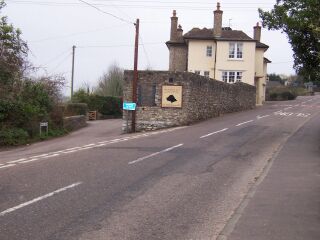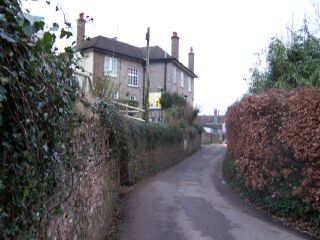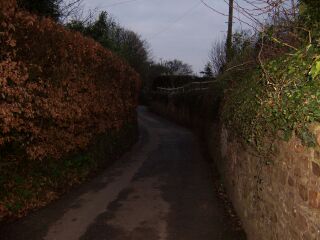
A view of the guest house and the entrance to Haye Lane behind it.

The legend of the Black Dog of Uplyme, first seen in a local cottage,
was first published in 1866 and was summarised by Theo Brown (1982, p.
119) as follows:
A farmer lived in the cottage, but every night a large black dog used to seat himself in the opposite chimney corner. Gradually the farmer grew accustomed to seeing it around, despite the jeers of his friends who wanted him to chase it away. ‘Why should I?’ he used to reply. ‘He costs me nothing – he eats nothing, he drinks nothing, he interferes with no one. He is the quietest and and frugalest creature in the house.’
However, one night his patience snapped. He seized a poker and chased the dog out of the room. And either in the porch or an attic room the dog made a sudden leap upward through the ceiling – the farmer struck up at it and made a huge hole in the plaster – and down fell a heap of coins. These were gold and silver of the reign of Charles I, and the sum was enough to enable the farmer to purchase the cottage opposite and start a wayside inn [which was apparently then named after the man’s lucky companion].
The dog thenceforth kept away from the farm, but took to patrolling Dog Lane.

In his, ‘The Book of Days’ (1879, Vol. 2, p. 434), Chambers
reported that, in 1856, a woman described her encounter with a black dog
here:
‘As I was returning to Lyme,’ said she, ‘one night with my husband down Dog Lane, as we reached about the middle of it, I saw an animal about the size of a dog meeting us. “What’s that?” I said to my husband. “What?” said he, “I see nothing.” I was so frightened I could say no more then, for the animal was within two or three yards of us, and had become as large as a young calf, but had the appearance of a black shaggy dog with fiery eyes, just like the description I had heard of the “black dog.” He passed close by me, and made the air cold dank as he passed along. Though I was afraid to speak, I could not help turning round to look after him, and I saw him growing bigger and bigger as he went along, till he was as high as the trees by the roadside, and then seeming to swell into a large cloud, he vanished in the air. As soon as I could speak, I asked my husband to look at his watch, and it was then five minutes past twelve. My husband said he saw nothing but a vapour or cloud coming up from the sea.
Whilst looking through the Theo Brown archive, I discovered a report
of a visit, and reported encounters, that Theo herself had made to the
same location in 1960, when it was an inn:
I visited the Inn on Tuesday, 17th May, 1960, and talked to Miss [X], the inn-keeper’s daughter. She told me the dog had been seen the previous autumn or late summer (1959) when there was a considerable coming and going of bed-and-breakfast holiday folk in transit. Sometime at the height of the season, in August or September, three people booked in one evening, a man and wife and son of about ten years old. After supper they all went for a stroll in the dimpsey [sic], down Haye Lane.
Suddenly the Black Dog appeared, very large, in mid-air about eye-level, floating from one hedge to the other, right across their path. They reported this strange event on their return to the Inn, and no-one knew quite what to make of it. Miss [X] seemed inclined to giggle at the absurdity of such a story, and only told me after some encouragement, glancing round at the customers in the pub, evidently expecting to be laughed at for passing it on. Evidently, the story had caused some embarrassment and no one had noted the names of the witnesses or the date of their stay, and nothing further was remembered about their appearance, etc. The Visitor’s Book was so crammed with entries Miss [X] considered it would be fruitless to look through it.
On this occasion, my Mother and I were eating our sandwiches in the lane behind the pub, where the wall of the Inn garden is very high, and has a curious kink in it, due to a drain or spring emerging; and from this hollow my Mother caught a glimpse of the dog emerging, a peculiarly melancholy look about it.
It is a shame that no records were kept of this encounter at the time.